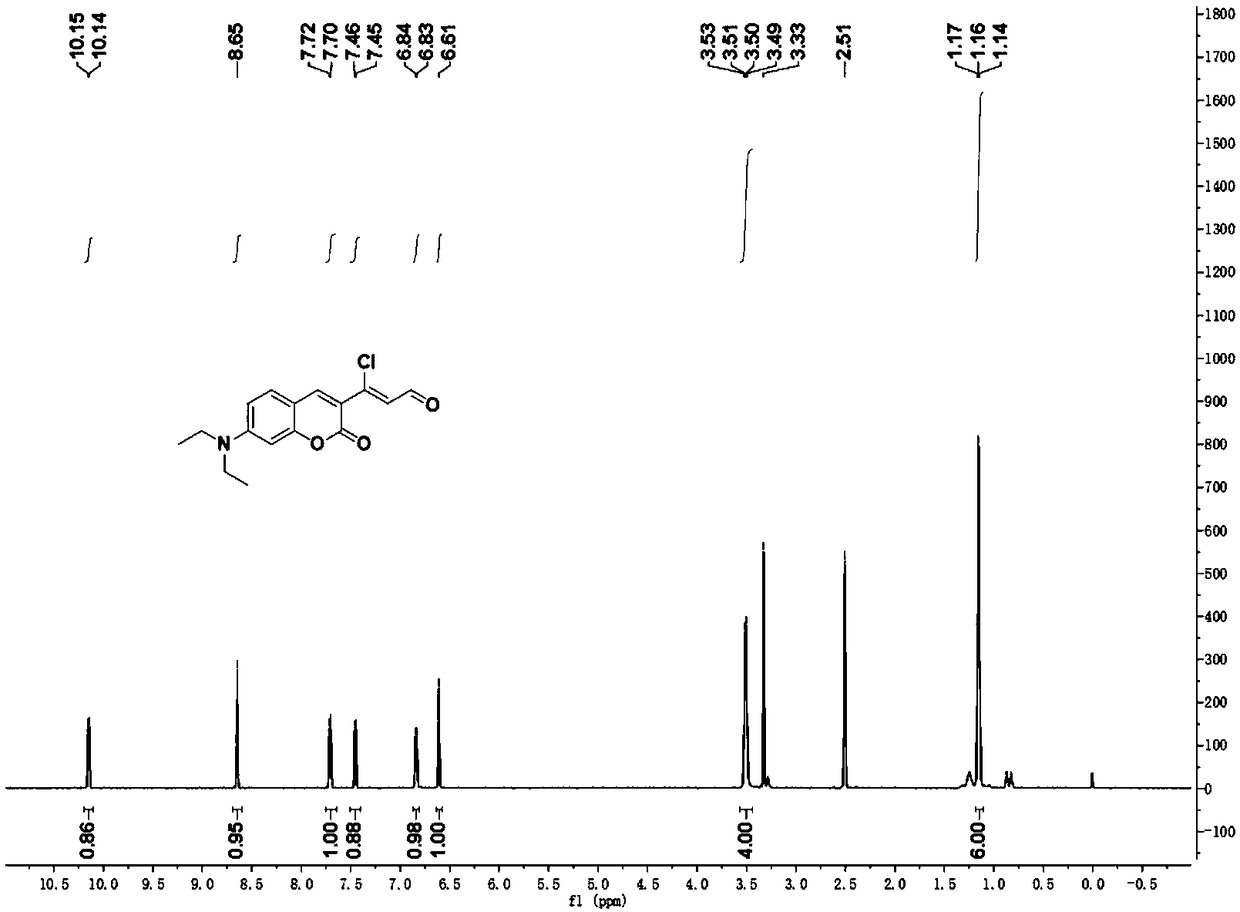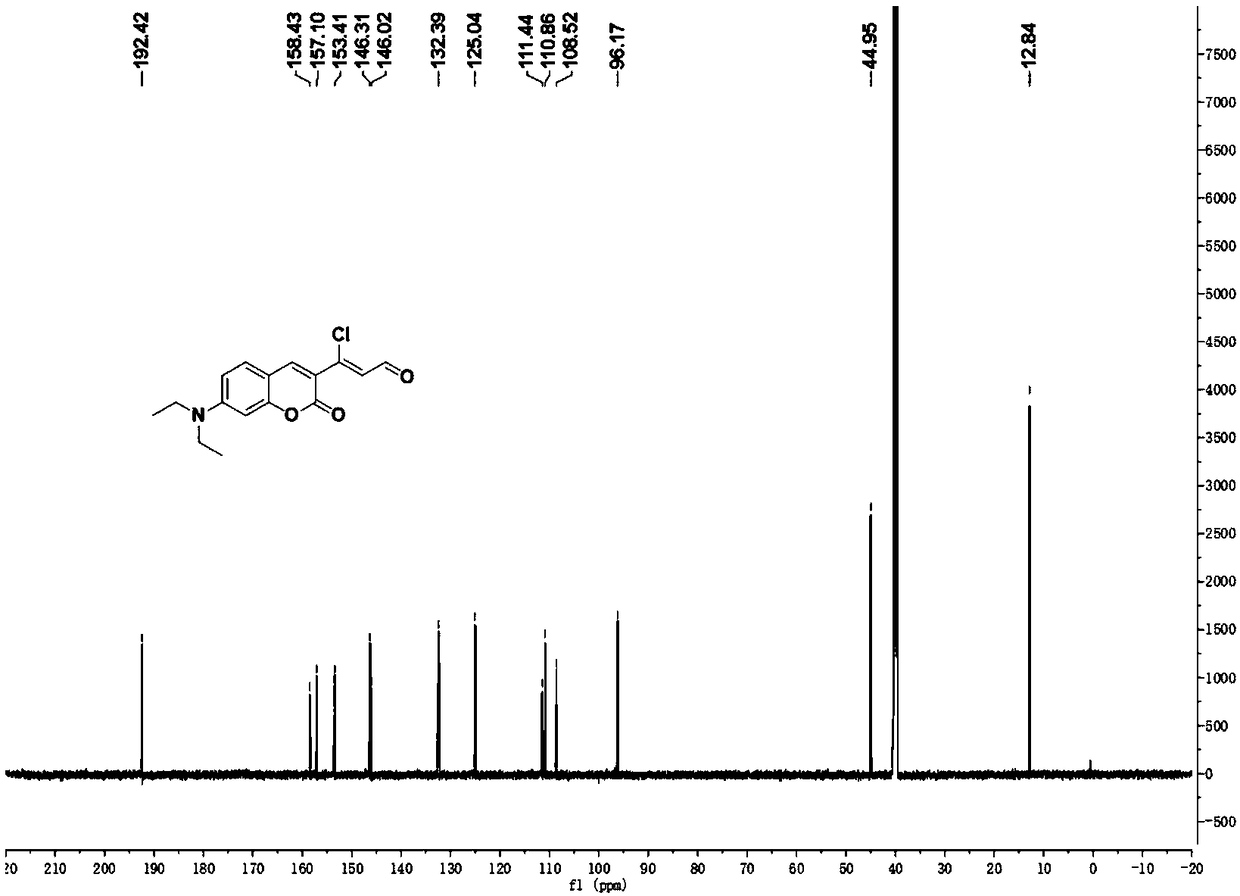A kind of so32-/hso3- detection reagent and its synthesis method and application
A technology of SO32- and detection reagents, applied in chemical instruments and methods, measuring devices, fluorescence/phosphorescence, etc., can solve problems such as damage to cells and tissues, and achieve a detection system with low cost, high sensitivity and selectivity, and simple detection methods. Effect
- Summary
- Abstract
- Description
- Claims
- Application Information
AI Technical Summary
Problems solved by technology
Method used
Image
Examples
Embodiment 1
[0026] Example 1 Synthesis and characterization of (Z)-3-chloro-(7-(diethylamino)-2-oxo-2-hydrogen-chromen-3-yl)acrolein
[0027] Under ice bath, slowly add 10mL of phosphorus oxychloride dropwise to 10mL of DMF solution, stir for half an hour, add 20mmol of 3-(diethylamino)phenol dissolved in DMF, and reflux at 80°C for 5h; after the reaction is completed, put The reaction solution was poured into 60mL of ice water and washed with Na 2 CO 3 The pH of the aqueous solution was adjusted to neutral, and a brown solid was precipitated, filtered with suction, washed with water, and finally recrystallized with ethanol to obtain 4-(diethylamino)-2-m-hydroxybenzaldehyde;
[0028]4-(diethylamino)-2-m-hydroxybenzaldehyde (1.93g, 10mmol), ethyl acetoacetate (1.95g, 15mmol) were refluxed in ethanol for 10 hours under the catalyst of 0.2mL piperidine, concentrated and cooled Afterwards, the yellow solid obtained by distillation under reduced pressure is 3-acetyl-7-(diethylamino)-2hydro-c...
Embodiment 2
[0032] Prepare a HEPES buffer solution with a pH of 7.4 and a concentration of 10 mM, and prepare 2 mM (Z)-3-chloro-(7-(diethylamino)-2-oxo-2-hydrogen-chromen-3-yl) in DMSO Acrolein solution; mix 2 mL of HEPES-DMSO (1:1, pH 7.4) solution and 5 μL of (Z)-3-chloro-(7-(diethylamino)-2-oxo-2-hydrogen-chromene -3-yl) DMSO solution of acrolein was added to a clean fluorescence cuvette, and SO 3 2- The solution is gradually added to the cuvette with a micro-injector, and is detected on the fluorescence spectrophotometer while adding the sample. 3 2- The addition of , the fluorescence intensity at 486nm gradually increased. Fluorescence emission map see Figure 4 .
Embodiment 3
[0034] Prepare a HEPES buffer solution with a pH of 7.4 and a concentration of 10 mM, and prepare 2 mM (Z)-3-chloro-(7-(diethylamino)-2-oxo-2-hydrogen-chromen-3-yl in DMSO ) acrolein solution; in 14 fluorescent cuvettes, add 2 mL of HEPES-DMSO (1:1, pH 7.4) solution and 5 μL of reagent in DMSO solution, and then add 14 μL of SO 3 2- , and 140 µL of each analyte: F - , Cl - ,Br - , I - ,N 3 - ,NO 3 - ,H 2 PO 4 - ,NO 2 - ,S 2 o 3 2- ,AcO - , SO 4 2- ,HS - , HCO 3 - and GSH are detected on a fluorescence spectrophotometer, and the histogram of the 486nm relative fluorescence intensity corresponding to different analytes is drawn, (see Figure 5 ). SO 3 2- The fluorescence intensity of the reagent changed from 177 to 5813, and other analytes basically did not cause changes in the fluorescence intensity of the reagent.
[0035] It has been proved by experiments that other analytes do not interfere with the system's response to SO 3 2- determination.
PUM
 Login to View More
Login to View More Abstract
Description
Claims
Application Information
 Login to View More
Login to View More - R&D
- Intellectual Property
- Life Sciences
- Materials
- Tech Scout
- Unparalleled Data Quality
- Higher Quality Content
- 60% Fewer Hallucinations
Browse by: Latest US Patents, China's latest patents, Technical Efficacy Thesaurus, Application Domain, Technology Topic, Popular Technical Reports.
© 2025 PatSnap. All rights reserved.Legal|Privacy policy|Modern Slavery Act Transparency Statement|Sitemap|About US| Contact US: help@patsnap.com



